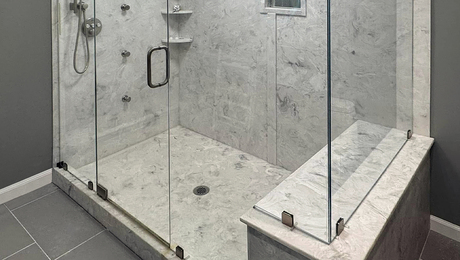Have an entry level bathroom (2 piece)with a small ceiling fan (rated35 cu ft/min) that I want to replace since its venting ability is minimal. Floor size is about 6′ x 8′ with a 10′ ceiling.
Problem is the bathroom is on the 1st floor of a 2-storey house – the fan was installed in the joists from above (finished floor above) since I can see no fasteners inside the fan housing and the 3″ diameter flex tubing runs within the joist cavity to an outside wall. The bathroom itself is not on any outside wall so a thru-the-wall installation is not an option.
Have checked HD & other big-box suppliers for a direct physical-size replacement but no go.
Ideas to get the existing fan out without pulling down a good part of the ceiling?
Most of the larger capacity fans (70 cu ft & up) use a 4″ diameter outlet. While I can use a 4” to 3″ reducer, will this unduly restrict the airflow? If yes, how much greater capacity would I require?
Alternately, is there a way to “pull” a larger diameter duct (run appears straight)?



















Replies
Don't be afraid to rip out some drywall, That stuff is very easy to repair, just go ahead and cut out what you need to get the job done. Try to not cut any within a foot of any wall so you will only be patching the ceiling. The fan was probably NOT installed from above but from below before the Sheetrock was hung. To get it out you need to pull the rock. You'll do well to replace the 3" flex with 4" hard aluminum duct while your at it and also will probably need a new wall termination to connect to where it penetrates the exterior wall.
M
------------------
"You cannot work hard enough to make up for a sloppy estimate."
In my case I didn't want to have to redo the ceiling texturing.
If your view never changes you're following the wrong leader
Hey lucky me - something's going my way. The builder forgot to popcorn the ceiling here. Managed to do most of the other rooms tho.
I had the same problem. Junk installed by the builder. I pulled the original wall cap and opened up the hole to clear a 4" pipe. Back inside the bathroom, removed all the guts to the old fan and found where it was attached. Marked out the new hole for the replacement fan unit and cut the drywall to suit. The bigger hole made it easy to remove the old unit without damage to the sheet rock.
Made up a long length of duct and slid in to the bath room from outside. Lined up with a bit of fiddleing and installed the fan unit. Popped a screw in from the inside to keep the duct in place. meatl taped ALL the little holes and the duct.
Back out side, cut the duct to length and install a new wall cap. Now it really works, but add a timer switch or it won't get used.
If you live in a colder climate not only should you switch to rigid ducting, but you should insulated it to avoid condensation drips.
I have done orthoscopic fan replacement before, but it's not fun.
I was replacing with a physically larger unit, so I first cut out to the size of the new unit and pried out the old one.
Then I installed a short length of flex between the reducer (that I had to use too) and the snap-in plastic gizmo on the fan body. Did this without snapping the plastic gizmo to the fan. Positioned the fan in the opening and tacked it in place, and then, at considerable risk of peeling the wallpaper, grabbed the plastic gizmo with my fingers and managed to snap it into the side of the box.
Not saying that this is always possible, and certainly not saying it's a cost-effective approach, but it worked OK this one time.
This was a 70 replacing a 50, and the difference, even with the reducer, is dramatic. Plus it's a lot quieter.